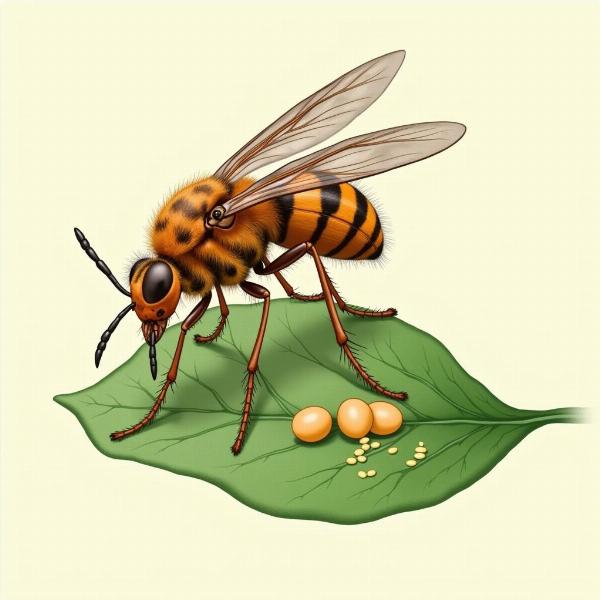Oviposition meaning in Hindi, a topic often searched by biology enthusiasts and students, refers to the process of laying eggs by female animals, particularly insects, birds, and reptiles. Understanding this term is crucial for comprehending animal reproductive strategies and life cycles. This article dives deep into the nuances of oviposition, exploring its Hindi equivalents, the fascinating diversity of oviposition methods, and its significance in the Indian ecological context.
Understanding Oviposition: From English to Hindi
What exactly does oviposition entail? It encompasses all the behaviors associated with egg-laying, from the selection of a suitable site to the final deposition of the eggs. In Hindi, oviposition can be translated in several ways, depending on the specific context and nuance. अंडनिक्षेपण (andanikṣepaṇ) is a more formal and scientific term, derived from Sanskrit roots meaning “egg deposition.” More colloquially, one might use अंडा देना (aṇḍā denā), which simply means “to lay eggs.” Another option is अंडे डालना (aṇḍe ḍālnā), meaning “to put eggs.” The choice of term depends on the audience and the level of formality desired.
 Oviposition Process in Insects
Oviposition Process in Insects
Diverse Methods of Oviposition
The methods of oviposition are incredibly diverse, reflecting the vast array of animal species that reproduce by laying eggs. Some insects, like butterflies, meticulously select specific host plants for their eggs, ensuring a ready food source for their larvae. Others, like grasshoppers, may simply scatter their eggs on the ground. Birds build intricate nests to protect their eggs, while reptiles often bury their eggs in sand or soil. This diversity showcases the remarkable adaptations that animals have evolved to ensure the survival of their offspring.
Oviposition in the Indian Context
India, with its rich biodiversity, boasts a wide range of oviparous animals. From the vibrant plumage of peafowl laying their eggs in hidden nests to the stealthy crocodiles burying theirs in riverbanks, oviposition plays a vital role in maintaining the delicate balance of Indian ecosystems. Understanding these processes is crucial for conservation efforts and appreciating the interconnectedness of life.
The Significance of Oviposition in Biology
Oviposition is far more than just the act of laying eggs. It represents a crucial link in the life cycle of numerous species, impacting population dynamics, ecosystem stability, and evolutionary adaptations. The study of oviposition provides valuable insights into animal behavior, reproductive strategies, and the complex interactions between organisms and their environment.
What influences oviposition site selection?
Factors influencing oviposition site selection are diverse and can include temperature, humidity, food availability for offspring, and the presence of predators or parasites. For example, some insects choose sites that offer protection from harsh weather, while others prioritize access to abundant food sources.
How does oviposition contribute to biodiversity?
Oviposition plays a vital role in maintaining biodiversity by ensuring the continuation of various species. The specific oviposition strategies of each species contribute to their unique niche in the ecosystem.
Conclusion: Unveiling the Wonders of Oviposition
Oviposition, or अंडनिक्षेपण (andanikṣepaṇ) in Hindi, is a fascinating biological process essential for the survival of countless animal species. Understanding its various forms, the factors influencing it, and its significance in the Indian ecological context enriches our appreciation for the intricate web of life. This article has aimed to provide a comprehensive overview of oviposition meaning in Hindi, delving into its different aspects and providing valuable insights for students, nature enthusiasts, and anyone curious about the wonders of the natural world.
FAQs
- What is the simplest Hindi translation for oviposition? अंडा देना (aṇḍā denā) is the simplest translation, meaning “to lay eggs.”
- Why is understanding oviposition important? It helps us understand animal reproductive strategies and life cycles, crucial for ecological studies and conservation efforts.
- Do all animals perform oviposition? No, only oviparous animals, which lay eggs, perform oviposition.
- What are some examples of oviparous animals in India? Peafowl, crocodiles, turtles, and many species of insects and birds are examples.
- Where can I learn more about oviposition in specific animal species? Scientific journals, books on animal biology, and online resources dedicated to specific species provide more in-depth information.
- What are the ecological implications of oviposition site selection? The chosen site directly impacts offspring survival rates due to factors like predator presence and resource availability.
- How does climate change affect oviposition? Changes in temperature and rainfall patterns can significantly influence oviposition timing and success.
Meaning-Hindi.in specializes in providing high-quality Hindi translation services for a wide range of documents, including business, legal, technical, educational, and website content. We offer accurate and culturally sensitive translations, ensuring your message resonates effectively with your target audience. Our expertise in various specialized fields allows us to handle complex terminology and nuanced cultural aspects with precision. For all your Hindi translation needs, contact us at [email protected] or call us at +91 11-4502-7584. Meaning-Hindi.in is your trusted partner for bridging the language gap and connecting you with the Hindi-speaking world.